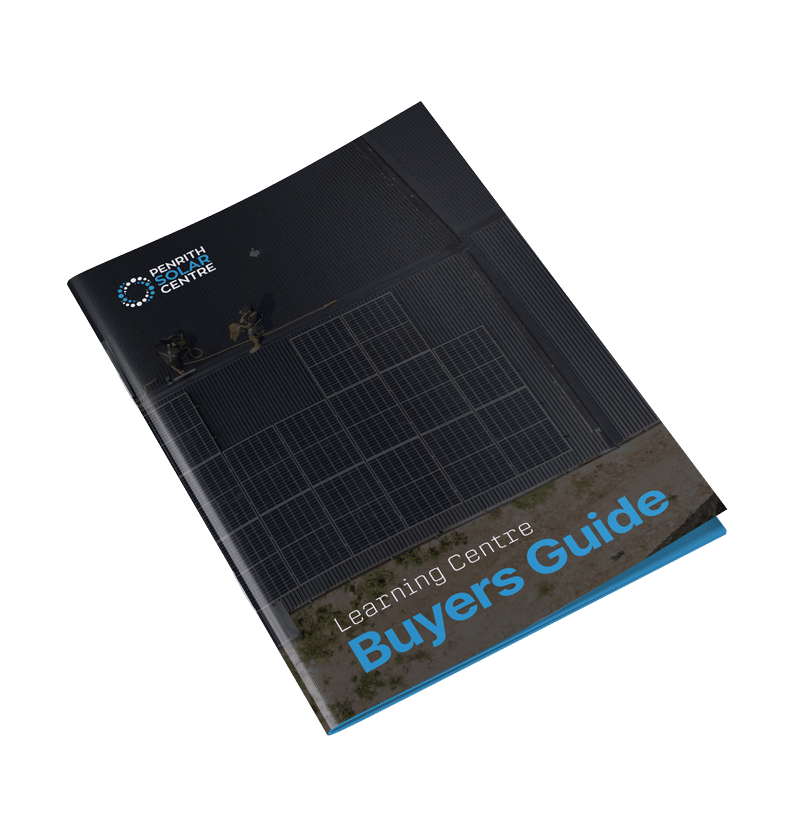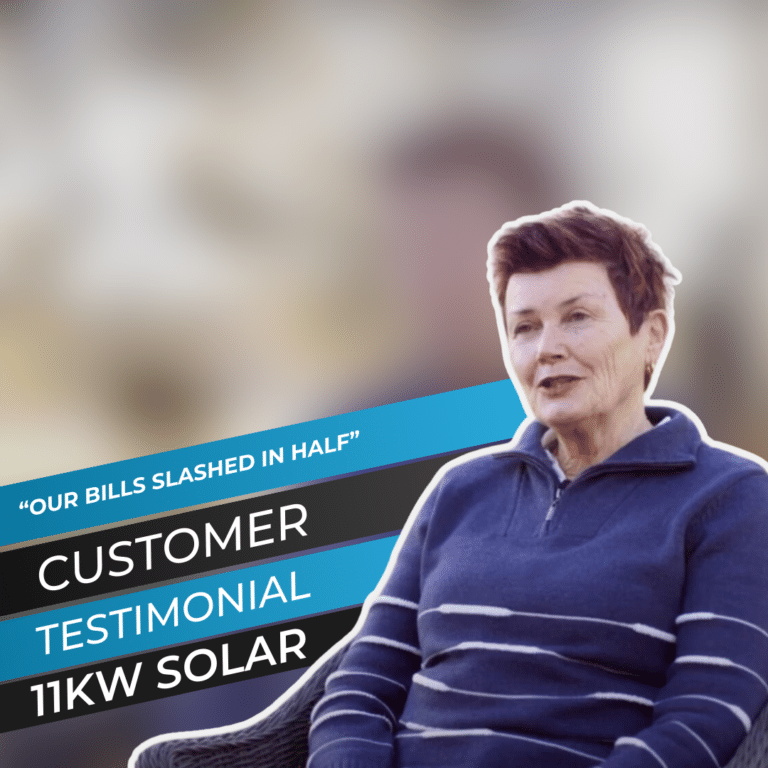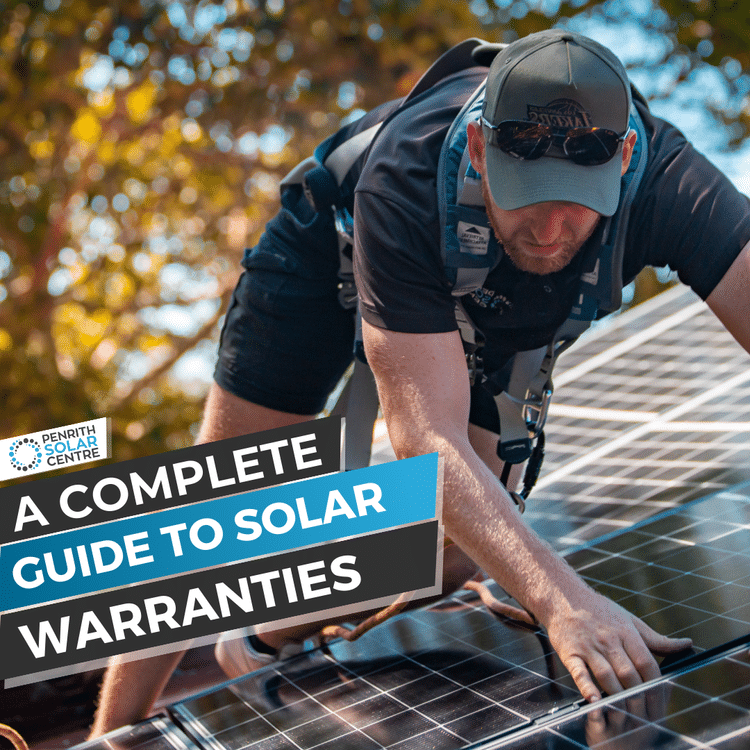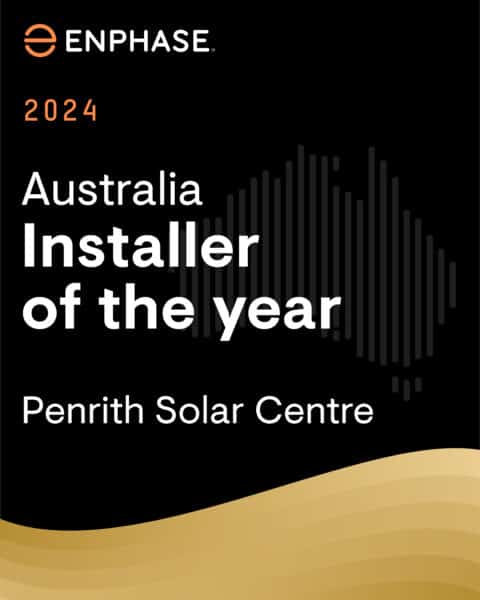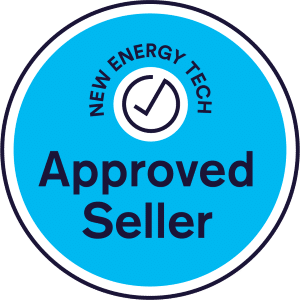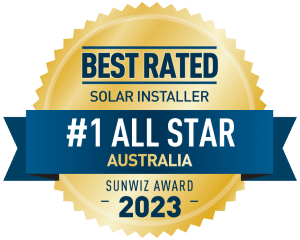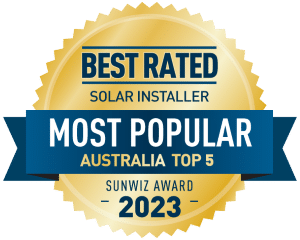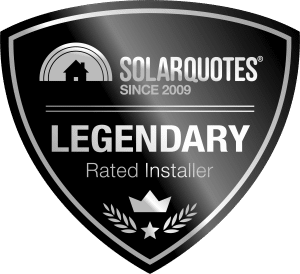
Shade. It’s the archenemy of solar panels everywhere. A tree, a chimney, or even your neighbour’s roofline might cast shade on your panels at some point during the day.
Now you’re wondering: can microinverters save the day? Or are they just an overhyped expense?
Here’s the good news: you’re not alone in asking this. At Penrith Solar Centre, we’ve helped plenty of people with less-than-perfect sunlight conditions. We sell microinverter solar systems because we believe in their value. We are a touch biased, but we’re here as educators first today.
In this article, you’ll learn the following:
- How Solar Panels and Inverters Work in Shade
- Do Microinverters Actually Work Better in Shaded Areas?
- Will Shade on One Panel Affect the Rest of My Solar Panel System?
- How Do Microinverters Compare to String Inverters When It Comes to Shade?
- Is the Cost of Microinverters Justified?
- What Are the Downsides to Microinverters?
- Are There Alternatives to Microinverters for Shaded Areas?
By the time you finish reading, you’ll know exactly how microinverters perform in shaded areas, how they stack up against other options, and whether they’re worth the investment for your system.
How Solar Panels and Inverters Work in Shade
Solar panels generate electricity when sunlight hits them. The more sunlight they get, the better they are at producing electricity.
But shading hits the breaks on the process. Even a small shadow across a panel can reduce a solar panel’s energy production significantly.
Here’s where inverters come in. Traditional solar setups use string inverters. With this setup, panels are linked together in a series, like Christmas lights. If shade hits one panel, the performance of the entire string takes a hit. It’s like having one bad lightbulb that dims the whole strand.
Microinverters work differently. Instead of connecting all your panels to one central inverter, each panel gets its own little inverter. This means that if shade hits one panel, it only affects that panel. The rest of your system keeps humming along.
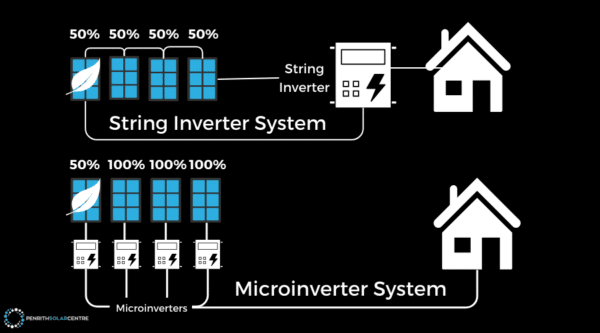
This is important because your string inverter or microinverters have a very important job in your solar system. Your panels output DC (direct current) electricity and your home runs on AC (alternating current) electricity. The microinverters (or string inverter) convert the DC power to AC power.
Your solar panels would be useless without them.
If you’re interested in learning a bit more about how microinverters compare to string inverters, you might want to check out the following article titled, Microinverters vs. String Inverters: A Transparent Comparison.
Do Microinverters Actually Work in Shaded Areas?
Yes, microinverters can make a big difference in shaded areas. Here’s a quick overview:
Microinverters ability to operate each panel independently makes sure that shading on one panel does not affect the output of the others. This is crucial for maintaining energy production on rooftops with partial shade from trees, chimneys, or other obstructions.
Adding to this advantage is the role of bypass diodes, an important feature found in all modern solar panels. These diodes act as electrical “shortcuts,” allowing electricity to bypass shaded or underperforming cells within a panel.
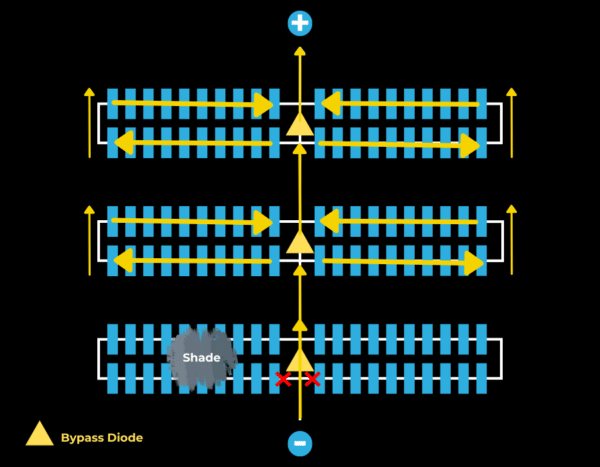
When part of a panel is shaded, the bypass diodes reroute the current around the shaded section, preventing it from dragging down the performance of the entire panel. The combination of bypass diodes and microinverters improves energy efficiency in shaded conditions.
Microinverters prevent the shade from causing a domino effect across your entire system.
If you’re interested in learning a bit more about how microinverters work, you might want to check out the following article titled, Do You Need Microinverters If You Have Bypass Diodes on Your Solar Panels?
Ready to go solar? Click here.
Will Shade on One Panel Affect the Rest of My Solar Panel System?
It depends on the type of solar system you’re investing in. Is it a string system or a microinverter system? Comparing the two is the best way to explain how they work.
String System: If a single panel is shaded and operating at 50% capacity, every other panel in the string also operates at 50%. This inefficiency can lead to a significant reduction in energy production, especially if shading is a recurring issue.
Microinverters: Microinverters eliminate this problem entirely. When a single panel with a microinverter is shaded, only that panel’s output is affected.
If one panel in a 10-panel microinverter system is shaded and operating at 50% efficiency, the remaining 9 panels will continue to produce energy at 100% efficiency.
The other panels in the system continue to produce energy at their full potential. This makes microinverters particularly valuable for homes with:
- Partial shading.
- Complex roof layouts.
- Panels installed at different orientations.
If you’re interested in learning a bit more about microinverters, you might want to check out the following article titled, Myths & Misconceptions About Solar Microinverters.
How Do Microinverters Compare to String Inverters When It Comes to Shade?
String Inverters and Shade
String inverters connect multiple solar panels in a series, meaning all the panels share one central inverter.
As we mentioned, when one panel in the series is shaded, its reduced energy output drags down the performance of all the panels in that string. Why is that?
It happens because the panels in a string inverter system must operate at the same current, so the entire string is limited to the output of the weakest panel.
Key Drawbacks of String Inverters in Shade:
- Performance Bottleneck: Shaded panels reduce the energy production of the entire string.
- Energy Loss: Even a small area of shade can cause significant energy losses.
- Limited Adaptability: String inverters struggle with shading caused by trees, chimneys, or other obstructions that affect only part of the system.
Microinverters and Shade
Microinverters optimise the energy output of each panel independently, making them ideal for roofs with partial shading or panels installed at different orientations.
Key Advantages of Microinverters in Shade:
- Panel Independence: Each panel operates independently, so shading on one does not impact the others.
- Flexibility in Design: Microinverters are well-suited for roofs with varying angles, orientations, or shading patterns.
If you’re interested in learning a bit more about how a microinverter system works, you might want to check out the following article titled, How Do Microinverter Systems Work?
Power up your savings. Click here.
Is the Cost of Microinverters Justified?
Microinverters are sometimes more expensive upfront than traditional string inverters, but they often provide a much more substantial return on investment.
This gain is due to the elimination of the “weakest link” effect that plagues string systems.
Monitoring and Performance: Microinverter systems often include advanced monitoring tools, like the Enphase Enlighten App, which allows homeowners to identify and address issues immediately. This proactive approach to energy efficiency delivers minimal downtime of your system and increased energy output over the system’s lifespan.
While microinverters have a higher upfront cost, the additional energy they produce often leads to greater long-term savings. Here’s a breakdown of how they can offset their cost:
- Higher Energy Output In the example of a partially shaded roof, a microinverter system will generate more energy annually than a string inverter system. Over a 25-year lifespan, this additional energy translates to thousands of dollars in savings on electricity bills.
- Reduced Maintenance Costs Microinverters come with a 25-year warranty, which is significantly longer than the typical 5–10 years for string inverters. This means fewer replacement costs over the life of the system.
- Replacing Component: Because string inverters have such a short lifespan, the cost of replacing them adds up and extends your payback period to about the same amount of time it would take to pay off a microinverter system.
If you’re interested in learning a bit more about how microinverters compare to string inverters from a cost point of view, you might want to check out the following article titled, Cost of Microinverters vs. Cost of String Systems.
What Are the Downsides to Microinverters?
While microinverters offer significant advantages in terms of performance, reliability, and efficiency, they are not without drawbacks. Understanding these downsides is essential for making an informed decision about whether a microinverter system is right for your home.
Upfront Costs: Microinverters sometimes cost more than traditional string inverters. This is because each solar panel requires its own microinverter, which increases the total equipment cost. Additionally, installation costs can be higher since microinverter systems involve more components and wiring.
Simple Roofs: Microinverters shine on roofs with shading, complex layouts, or panels facing multiple directions. However, for a simple roof with no shading and all panels facing the same direction, a string inverter may provide similar energy production at a lower cost.
Too Much of a Good Thing: For some homeowners, the advanced features of microinverters, like panel-level monitoring, may not be necessary. These features add cost and complexity but may go underutilised in systems designed for straightforward energy production.
If you’re interested in learning a bit more about the benefits of microinverters, you might want to check out the following article titled, What Are the Benefits of an Enphase Microinverter Solar System?
Let’s talk solar savings. Click here.
Are There Alternatives to Microinverters for Shaded Areas?
Power Optimisers
Power optimisers are a popular alternative to microinverters. These devices are installed at the panel level, much like microinverters, and work to optimise the energy output of each panel.
However, unlike microinverters, power optimisers do not convert DC electricity to AC at the panel level. Instead, they send optimised DC power to a centralised string inverter for conversion.
How They Work: Power optimisers adjust the voltage and current of each panel for maximum energy output, regardless of shading or other performance issues on individual panels.
Key Benefits:
- Panel Independence: Like microinverters, power optimisers allow each panel to operate independently, reducing the impact of shading.
- Lower Cost: Power optimisers are generally slightly less expensive than microinverters.
- Compatibility: They work with most string inverters, offering flexibility in system design.
Limitations:
- Centralised Inverter: Since power optimisers rely on a string inverter, the system still has a single point of failure.
- Maintenance: If the string inverter fails, the entire system goes down until it is replaced. This extends your payback period.
Hybrid Inverters
Some advanced hybrid inverters (like the one in the Powerwall 3) also include Maximum Power Point Tracking (MPPT) capabilities for multiple strings of panels. These inverters can handle shading better than traditional string inverters but are not as efficient as microinverters or power optimizers.
How They Work: They optimise power output from multiple panel strings with independent MPPTs.
Key Benefits:
- Battery Integration: Simplifies the addition of battery storage to the system.
- MPPT Flexibility: Some hybrid inverters have multiple MPPTs to handle shading better than a single-string system.
- Cost-Effective: More affordable than a microinverter system when combined with battery storage. Please note that without battery storage, there’s no need for a hybrid inverter.
Limitations:
- String-Level Dependency: Panels in the same string are still affected by shading, although MPPTs can mitigate some of this impact.
- Limited Optimisation: Not as effective as microinverters or power optimizers in managing severe shading.
Solar Panel Repositioning or Ground Mounted Solar Panels
In some cases, addressing shading issues doesn’t require additional equipment. The layout of solar panel designs to avoid shading entirely can be a cost-effective solution.
At Penrith Solar Centre, we also offer ground-mounted solutions for your system if you have the space on your property.
How It Works: By analysing the roof’s shading patterns throughout the year, installers can position panels to minimise shading or avoid it altogether.
Key Benefits of Repositioning Panels:
- Upfront Cost: Reduces overall system cost.
- Panel Performance: Ensures panels are placed in locations with maximum sunlight exposure.
Limitations:
- Not Always Feasible: Some roofs may have unavoidable shading due to trees, chimneys, or neighbouring structures.
- Missed Opportunities: This may require sacrificing potential panel space, reducing total energy production.
Of course, you could always cut down the tree, but who wants to do that?
If you’re interested in learning a bit more about the difference between microinverters and DC optimisers, you might want to check out the following article titled, Microinverters vs. DC Optimisers: Which Is Better?
Click here to get started with solar.
Microinverters Have All the Light Moves
Now you know a bit more about how microinverters behave in shaded environments. In comparison to string inverter systems, they handle shade like a champ. But, there are situations where microinverters may not be the best choice.
At Penrith Solar Centre, we’re a little biased because we install microinverters. However, we do believe in the product and what it can do for your energy lifestyle. Microinverters handle shade better than any other option and will save you the most money over time.
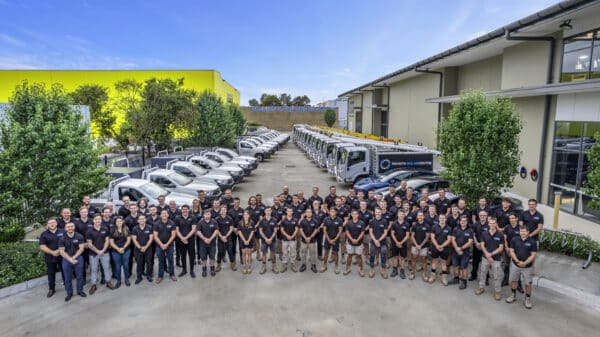
If you’re interested in learning more about how a microinverter system performs compared to Powerwall 3, you might want to check out the following article titled, Enphase Microinverters vs. Tesla Powerwall 3: Which Solar Panel System is Right for You?
